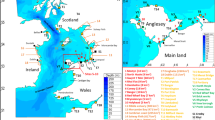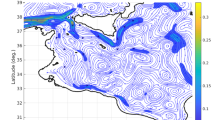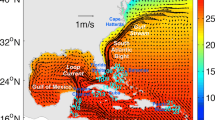Abstract
The temporal variation and the spatial structure of marine populations strongly depend on the early life stages of the individuals and on their interaction with the environment. The physical dispersion of propagules (eggs and larvae) is a fundamental aspect, conditioning the successful recruitment of juveniles in the adult population. Coastal transitional ecosystems such as lagoons plays a role of nursery for species with economic relevance, such as demersal fishes, mollusks and crustaceans. Those environments promote the recruitment of the early stages for several organisms because they act as area of retention for propagules and concentration for resources. We applied in three different European coastal lagoon a lagrangian particle tracking model coupled with a hydrodynamic model, and developed a method to evaluate the connectivity inside a lagoon and between a lagoon and the sea. Each particle represents a generic passive pelagic larva with a duration of one month. The average connectivity has been estimated after two years of simulation under realistic tide and wind forcings. Our results allow to characterize the lagoons behavior considering different spatial scales and to compare the dynamics of different systems. This study is a first step toward a better knowledge of the factors influencing the ecological role of coastal lagoons.










Similar content being viewed by others
References
Andrefouet, S., S. Ouillon, R. Brinkman, J. Falter, P. Douillet, F. Wolk, R. Smith, P. Garen, E. Martinez, V. Laurent, C. Lo, G. Remoissenet, B. Scourzic, A. Gilbert, E. Deleersnijder, C. Steinberg, S. Choukroun, and D. Buestel. 2006. Review of solutions for 3D hydrodynamic modeling applied to aquaculture in South Pacific atoll lagoons. Marine Pollution Bulletin. doi:10.1016/j.marpolbul.2006.07.014.
Basterretxea, G., A. Jordi, I.A. Catalan, and A. Sabatesm. 2012. Model-based assessment of local-scale fish larval connectivity in a network of marine protected areas. Fisheries Oceanography. doi:10.1111/j.1365-2419. 2012.00625.x.
Bastian, M., S. Heymann, and M. Jacomy. 2009. Gephi: an open source software for exploring and manipulating networks. International AAAI Conference on Weblogs and Social Media. 2009.
Bellafiore, D., and G. Umgiesser. 2010. Hydrodynamic coastal processes in the North Adriatic investigated with a 3D finite element model. Ocean Dynamics. doi:10.1007/s10236-009-0254-x.
Chiswell, S.M., and G.J. Rickard. 2011. Larval connectivity of harbours via ocean currents. A New Zealand study. Continental Shelf Research. doi:10.1016/j.csr.2011.03.012.
Chubarenko, B.V., and I.P. Chubarenko. 1995. Modelling of currents in the Curonian lagoon during storm wind influence. Meteorology and Hydrology, 5:54–60.
Cowen, R.K., G. Gawarkiewic, J. Pineda, S.R. Thorrold, and F.E. Werner. 2007. Population Connectivity in Marine Systems An Overview. Oceanography, 20(3):14–21.
Cucco, A., and G. Umgiesser. 2006. Modeling the Venice Lagoon residence time. Ecological Modelling, 193(1–2):34–51.
Cucco, A., G. Umgiesser, C. Ferrarin, A. Perilli, D.M. Canu, and C. Solidoro. 2009. Eulerian and lagrangian transport time scales of a tidal active coastal basin. Ecological Modelling. doi:10.1016/j.ecolmode1.2009.01.008.
De Pascalis, F., A Perez-Ruzafa, J. Gilabert, C. Marcos, and G. Umgiesser. 2012. Climate change response of the Mar Menor coastal lagoon (Spain) using a hydrodynamic finite element model. Estuarine Coastal And Shelf Science. doi:10.1016/j.ecss.2011.12.002.
Dye, A., and F. Barros. 2005. Spatial patterns of macrofaunal assemblages in intermittently closed/open coastal lakes in new south wales, Australia. Estuarine, Coastal and Shelf Science, 64:357–371.
Ferrarin, C., A. Razinkovas, S. Gulbinskas, G. Umgiesser, and L. Bliudziute. 2008a. Hydraulic regime-based zonation scheme of the Curonian Lagoon. Hydrobiologia. doi:10.1007/s10750-008-9454-5.
Ferrarin, C., G. Umgiesser, A. Cucco, T.W. Hsu, A. Roland, and C.L. Amos. 2008b. Development and validation of a finite element morphological model for shallow water basins. Coastal Engineering. doi:10.1016/j.coastaleng.2008.02.016.
Ferrarin, C., A. Cucco, G. Umgiesser, Bellafiore D., and Amos C.L. 2010. Modelling fluxes of water and sediment between Venice Lagoon and the sea. Continental Shelf Research. doi:10.1016/j.csr.2009.08.014.
Funkquist, L. 2002. A unified model system for the Baltic Sea. In Building the european capacity in operational oceanography, Proceedings, Elsevier Oceanography Series, vol 69, eds. Dahlin, H., Flemming, N.C., Petersson, S.E., Nittis, K., 516-518. Athens: 3rd International Conference on Building the European Capacity for Operational Oceanography.
Gacic, M., V. Kovacevic, A. Mazzoldi, J. Paduan, F. Arena, I. Mosquera, G. Gelsi, and G. Arcari. 2002. Measuring water exchange between the venetian lagoon and the open sea. EOS, Transaction, 83(20):217–221.
Gacic, M., I. Mosquera, V. Kovacevic, A. Mazzoldi, V. Cardin, F. Arena, and G. Gelsi. 2004. Temporal variations of water flow between the Venetian lagoon and the open sea. Journal of Marine systems. doi:10.1016/j. marsys.2004.05.025.
Ghezzo, M., S. Guerzoni, A. Cucco, and G. Umgiesser. 2010. Changes in Venice Lagoon dynamics due to construction of mobile barriers. Coastal Engineering. doi:10.1016/j.coastaleng.2010.02.009.
Ghezzo, M., A. Sarretta, M. Sigovini, S. Guerzoni, D. Tagliapietra, and G. Umgiesser. 2011. Modeling the inter-annual variability of salinity in the lagoon of Venice in relation to the water framework directive typologies. Ocean & Coastal Management. doi:10.1016/j.ocecoaman.2011.06.007.
Guelorge, O., and J. Perthuisot. 1983. Le domaine paralique: expressions géologiques, biologiques et économiques du confinement. Travaux du laboratoire de géologie. Presses de École Normale Supérieure de Paris, 16:1–136.
Herbert, R.J.H., J. Willis, E. Jones, K. Ross, R. Huebner, J. Humphreys, A. Jensen, and J. Baugh. 2012. Invasion in tidal zones on complex coastlines: modelling larvae of the non-native Manila clam, Ruditapes philippinarum, in the UK. Journal Of Biogeography. doi:10.1111/j.1365-2699.2011.02626.x.
Jones, G.P., G.R. Almany, G.R. Russ, P.F. Sale, R.S. Steneck, M.J.H. van Oppen, and B.L. Willis 2009a. Larval retention and connectivity among populations of corals and reef fishes: history, advances and challenges. Coral reefs, doi:10.1007/s00338-009-0469-9, Workshop on Connectivity and Resilience Sustaining Coral Reefs during the coming Century, Townsville, Australia, 2007.
Jones, G.P., G.R. Russ, P.F. Sale, and R.S. Steneck. 2009b. Theme section on “Larval connectivity, resilience and the future of coral reefs”. Coral reefs. doi:10.1007/s00338-008-0440-1.
Jurevic̀ius, R. 1959. Hydrodynamic conditions in the Curonian Lagoon, vol. 1, 69–108.
Kjerve, B, and K Magill. 1989. Geographic and hydrodynamic characteristics of shallow coastal lagoons. Marine Geology, 88:187–199.
Kool, J.T., A. Moilanen, and E.A. Treml. 2013. Population connectivity: recent advances and new perspectives. Landscape Ecology. doi:10.1007/s10980-012-9819-z.
Larsen, L.G., J. Choi, M.K. Nungesser, and J.W. Harvey. 2012. Directional connectivity in hydrology and ecology. Ecological Applications, 22(8):2204–2220.
Leis, J.M., L. Van Herwerden, and H.M. Patterson 2011. Estimating connectivity in marine fish populations: what works best? In Oceanography and marine biology: an annual review., Oceanography and Marine Biology, vol 49, eds. Gibson, R.N., Atkinson, R.J.A., Gordon, J.D.M., 193–234.
Lett, C., S.D. Ayata, M. Huret, and J.O. Irisson. 2010. Biophysical modelling to investigate the effects of climate change on marine population dispersal and connectivity. Progress in Oceanography. doi:10.1016/j.pocean. 2010.09.005.
Levin, L. 2006. Recent progress in understanding larval dispersal: new directions and digressions. Integrative and Comparative Biology. doi:10.1093/icb/icj024.
Mantovanelli, A., M.L. Heron, S.F. Heron, and C.R. Steinberg. 2012. Relative dispersion of surface drifters in a barrier reef region. Journal Of Geophysical Research-Oceans. doi:10.1029/2012JC008106.
Marinone, S.G., M.F. Lavin, and A. Pares-Sierra. 2011. A quantitative characterization of the seasonal Lagrangian circulation of the Gulf of California from a three-dimensional numerical model. Continental Shelf Research. 10.1016/j.csr.2011.05.014.
Mileikovsky, S. 1971. Types of larval development in marine bottom invertebrates, their distribution and ecological significance: a re-evaluation. Marine Biology, 19:193–213.
Mitarai, S., D.A. Siegel, J.R. Watson, C. Dong, and J.C McWilliams. 2009. Quantifying connectivity in the coastal ocean with application to the Southern California Bight. Journal of Geophysical Research-Oceans. doi:10.1029/2008JC005166.
Paris, C.B., L.M. Cherubin, and R.K. Cowen. 2007. Surfing, spinning, or diving from reef to reef: effects on population connectivity. Marine Ecology Progress Series. doi:10.3354/meps06985.
Perez-Ruzafa, A., and C. Marcos-Diego. 1992. Colonization rates and dispersal as essential parameters in the confinement theory to explain the structure and horizontal zonation of lagoon benthic assemblages. Technical Report Rapport Commission International Mer Medit, 33:100.
Perez-Ruzafa, A., J. Gilabert, J. Gutierrez, A. Fernandez, C. Marcos, and S. Sabah. 2002. Evidence of a planktonic food web response to changes in nutrient input dynamics in the Mar Menor coastal lagoon, Spain. Hydrobiologia, 475(/6): 359–369. doi:10.1023/A:1020343510060.
Perez-Ruzafa, A., A. Fernandez, C. Marcos, J. Gilabert, J. Quispe, and J. Garcia-Charton. 2005. Spatial and temporal variations of hydrological conditions, nutrients and chlorophyll a in a Mediterranean coastal lagoon (May Menor, Spain). Hydrobiologia, 550: 11–27. doi:10.1007/s10750-005-4356-2. 1st International Conference on Southern European Coastal Lagoons, Ferrara, ITALY Nov. 10-12, 2003.
Platell, M., and I. Potter. 1996. Influence of water depth, season, habitat and estuary location on the macrobenthic fauna of a seasonally closed estuary. Journal of the Marine Biological Association of the United Kingdom, 76:1–21.
Raudsepp, U., and T. Kouts. 2002. Wind driven circulation the Curonian lagoon. Environmental and Chemical Physics, 24(3):151–155.
Sanders, H. 1992. Marine benthic diversity: a comparative study. American Naturalist, 102(925):243–282.
Tagliapietra, D., M. Sigovini, and A.V. Ghirardini. 2009. A review of terms and definitions to categorise estuaries, lagoons and associated environments. Marine And Freshwater Research. doi:10.1071/MF08088.
Tagliapietra, D.P. Magni, and M. Sigovini. 2012. Saprobity: a unified view of benthic succession models for coastal lagoons. Hydrobiologia, 686(1):15–28.
Thomas, Y., R. Le Gendre, P. Garen, F. Dumas, and S. Andrefouet. 2012. Bivalve larvae transport and connectivity within the Ahe atoll lagoon (Tuamotu Archipelago), with application to pearl oyster aquaculture management. Marine Pollution Bulletin. doi:10.1016/j.marpolbul.2011.12.027.
Treml, E.A., P.N. Halpin, D.L. Urban, and L.F. Pratson. 2008. Modeling population connectivity by ocean currents, a graph-theoretic approach for marine conservation. Landscape Ecology. doi:10.1007/s10980-007-9138-y.
Treml, E.A., J.J. Roberts, Y. Chao, P.N. Halpin, H.P. Possingham, and C. Riginos. 2012. Reproductive output and duration of the pelagic larval stage determine seascape-wide connectivity of marine populations. Integrative and Comparative Biology. doi:10.1093/icb/ics101.
Umgiesser, G., D. Canu, A. Cucco, and C. Solidoro. 2004. A finite element model for the Venice Lagoon. Development, set up, calibration and validation. Journal of Marine Systems. doi:10.1016/j.jmarsys.2004.05.009.
Umgiesser, G., C. Ferrarin, A. Cucco, F. De Pascalis, D. Bellafiore, M. Ghezzo, and M. Bajo. 2014. Comparative hydrodynamics of 10 Mediterranean lagoons by means of numerical modeling. Journal of Geophysical Research - Oceans. doi:10.1002/2013JC009512.
Xueping, G., Yuanyuan C., and Zhang C. 2013. Water renewal timescales in an ecological reconstructed lagoon in china. Journal of Hydroinformatics. doi:10.2166/hydro.2013.136.
Zemlys, P., C. Ferrarin, G. Umgiesser, S. Gulbinskas, and D. Bellafiore. 2013. Investigation of saline water intrusions into the Curonian Lagoon (Lithuania) and two-layer flow in the Klaipeda Strait using finite element hydrodynamic model. Ocean Science. doi:10.5194/os-9-573-2013.
Zuliani, A., L. Zaggia, F. Collavini, and R. Zonta. 2005. Freshwater discharge from the drainage basin to the Venice Lagoon (Italy). Environment International, 31(7): 929–938.
Acknowledgments
This study has been started in the context of the DSS-Pesca project and developed in the context of the RITMARE project, by the cooperation of lines SP3-WP4-AZ5 and SP2-WP2-AZ1-UO8. We are grateful to dr. Ferrarin Christian for the scientific suggestions. One of the authors was supported by a grant (APR, 18869/EE/13) for research stays of the Jimnez de la Espada mobility, cooperation and internationalization program of the Seneca Foundation in the framework of the Plan de Ciencia, Tecnología e Innovacíon de la Regíon de Murcia (2011-2014).We wish to acknowledge Agencia Estatal de Meteorologia and Organismo Público Puertos del Estado for the metheorological and hydrographical data provided respectively.
Author information
Authors and Affiliations
Corresponding author
Additional information
Communicated by: Wayne S. Gardner
Rights and permissions
About this article
Cite this article
Ghezzo, M., De Pascalis, F., Umgiesser, G. et al. Connectivity in Three European Coastal Lagoons. Estuaries and Coasts 38, 1764–1781 (2015). https://doi.org/10.1007/s12237-014-9908-0
Received:
Revised:
Accepted:
Published:
Issue Date:
DOI: https://doi.org/10.1007/s12237-014-9908-0




